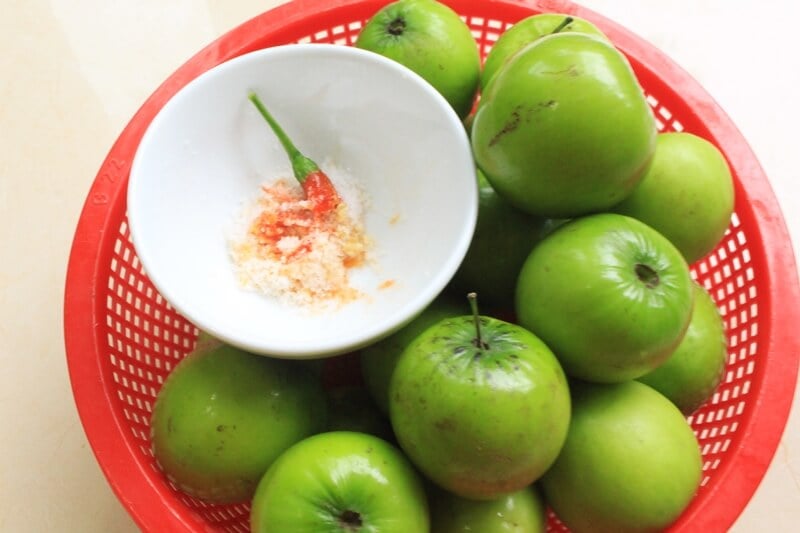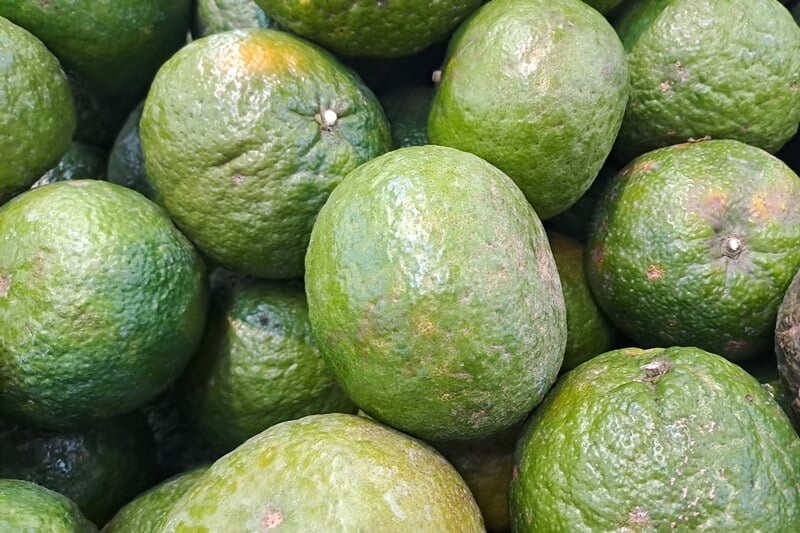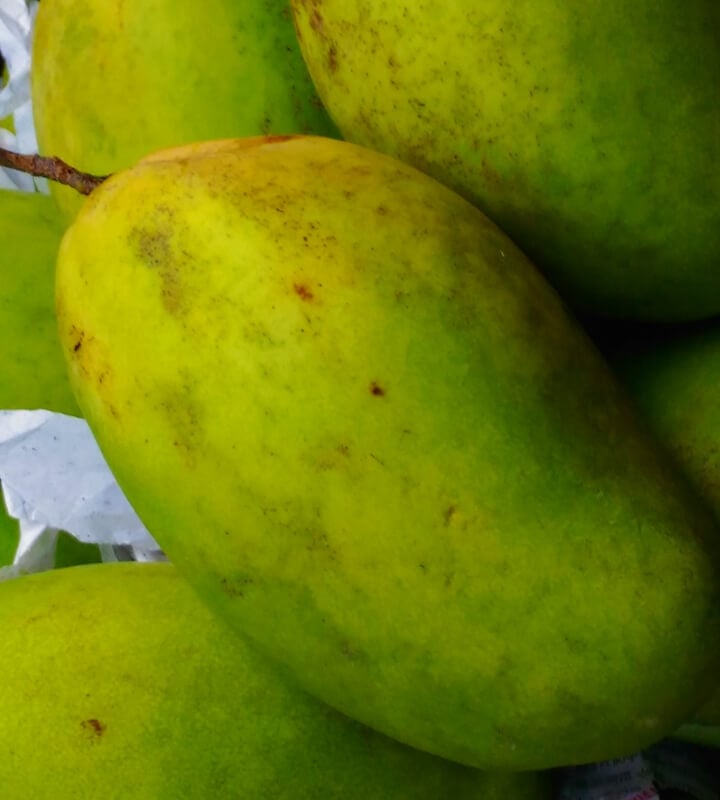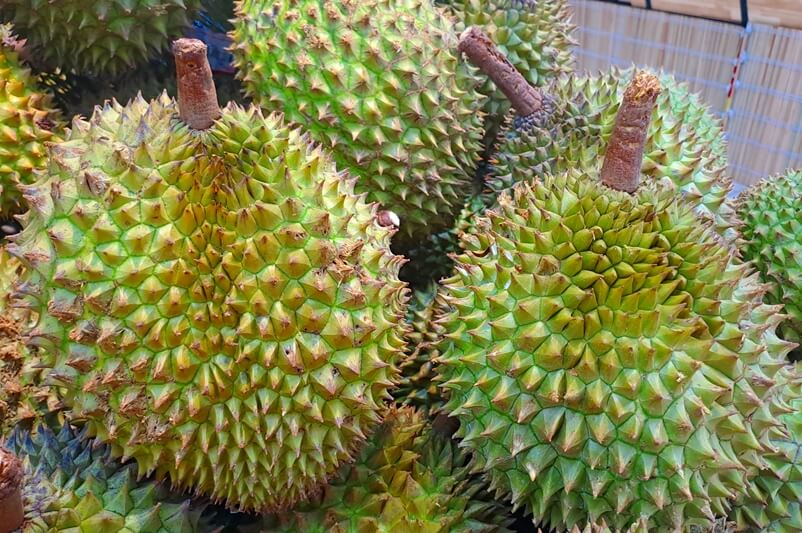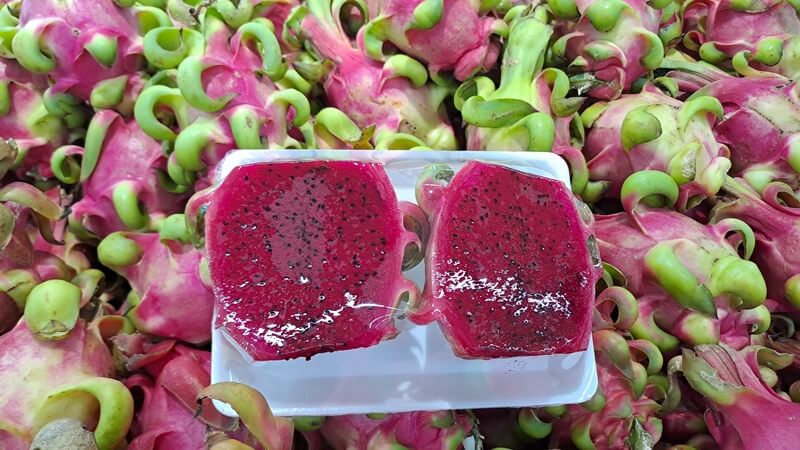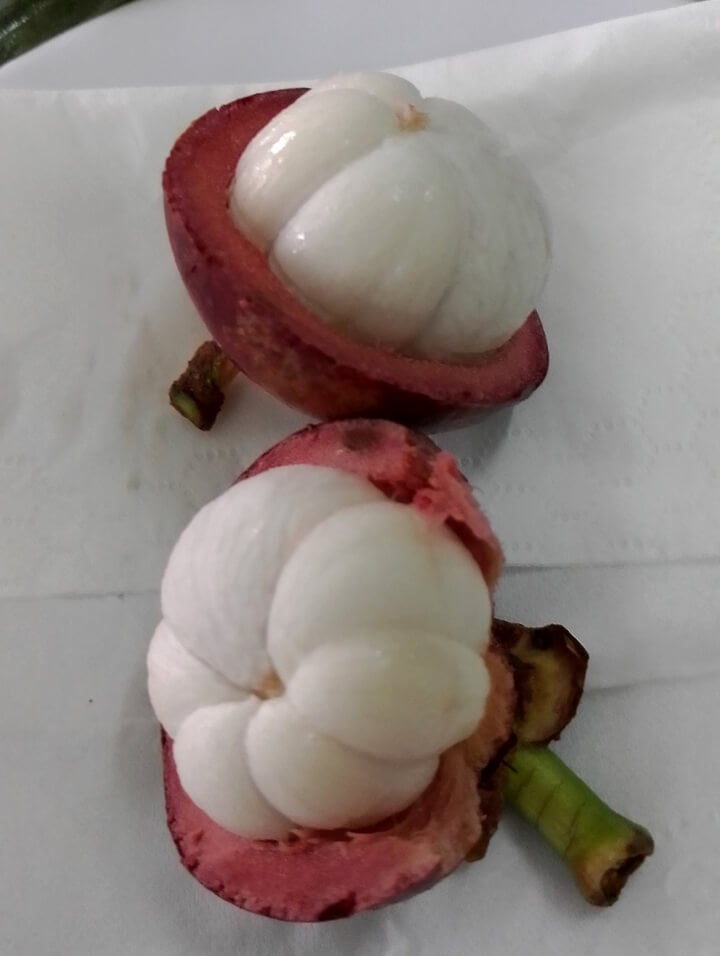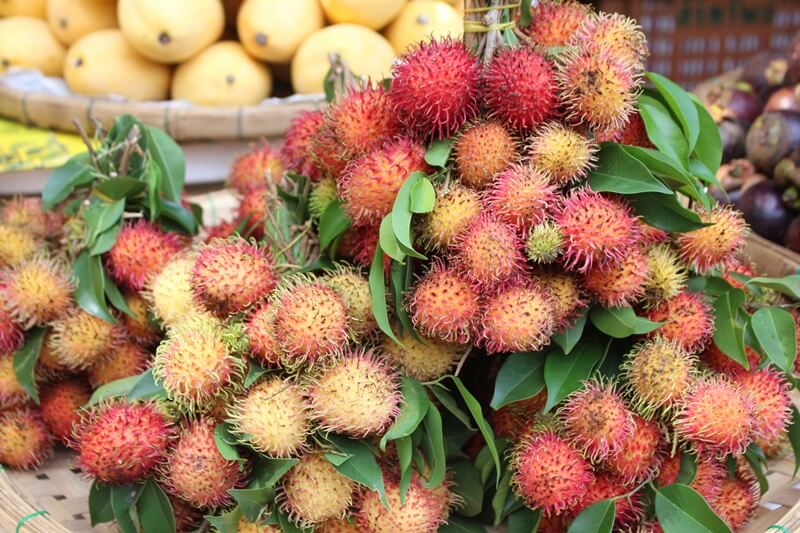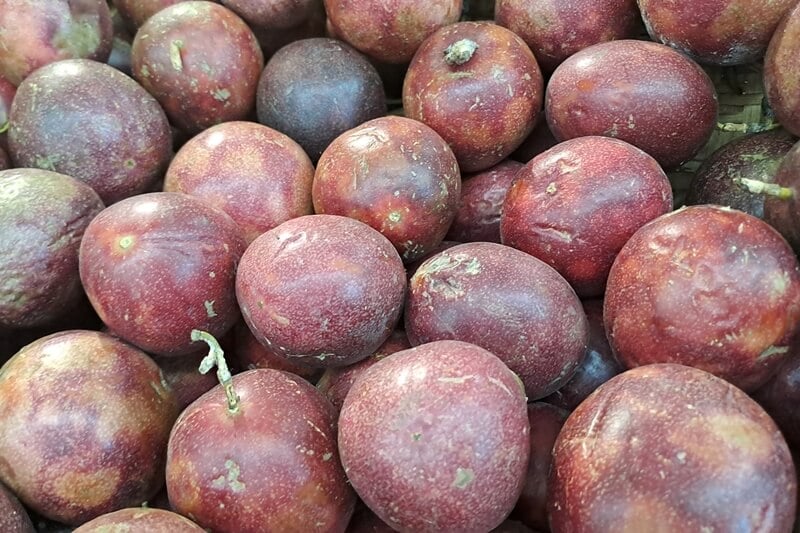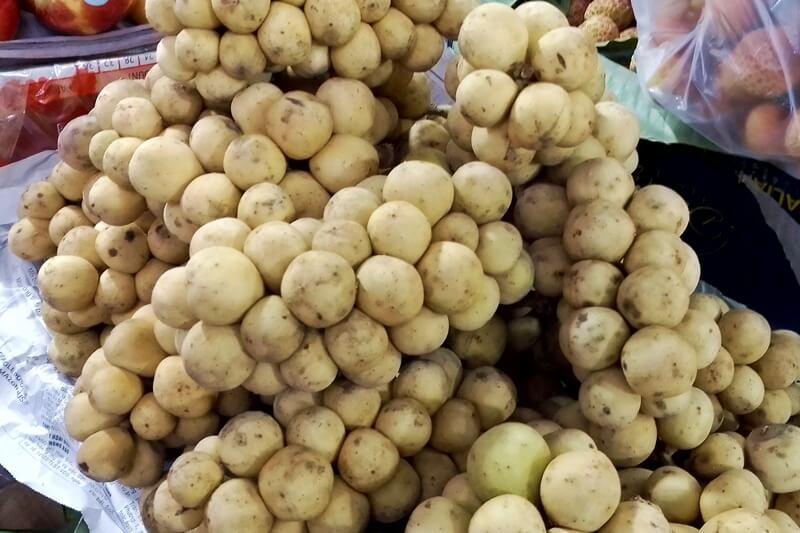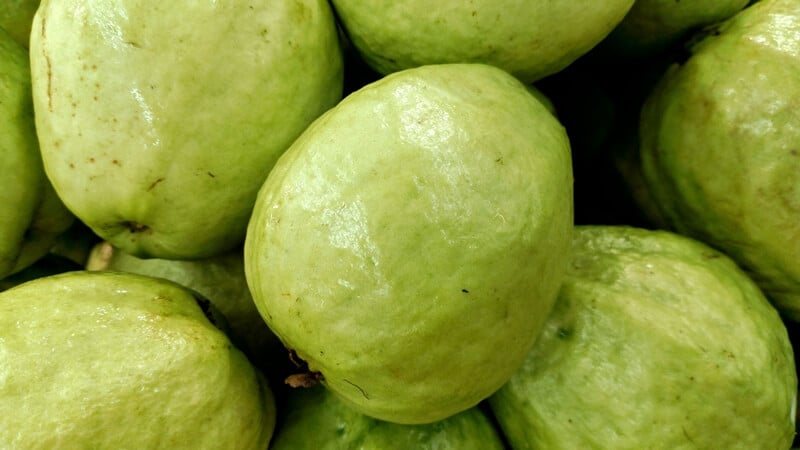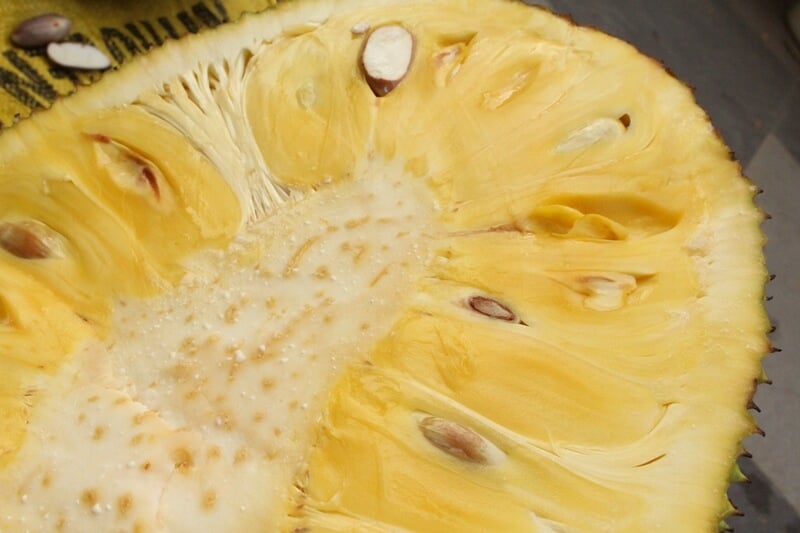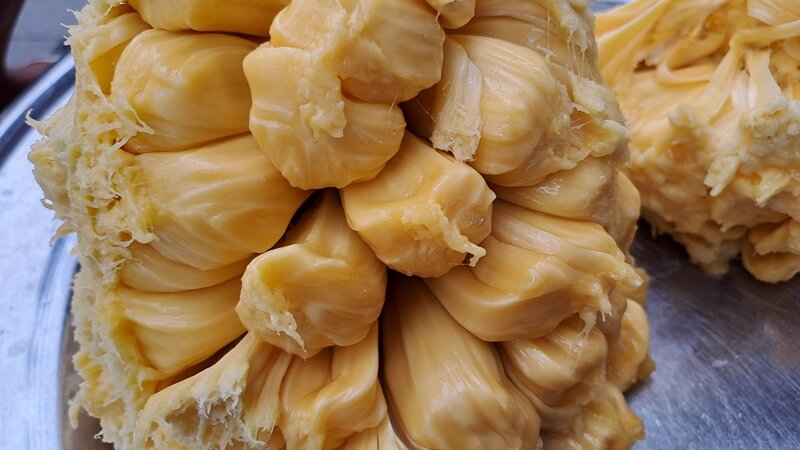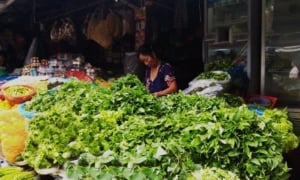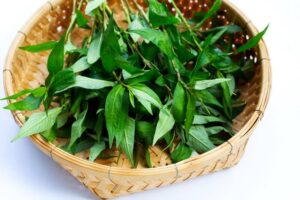Vietnam has a tropical climate with abundant soil and freshwater suitable for growing fruit trees. Many Vietnamese fruits are famous among the locals and tourists, sold throughout the country and exported globally.
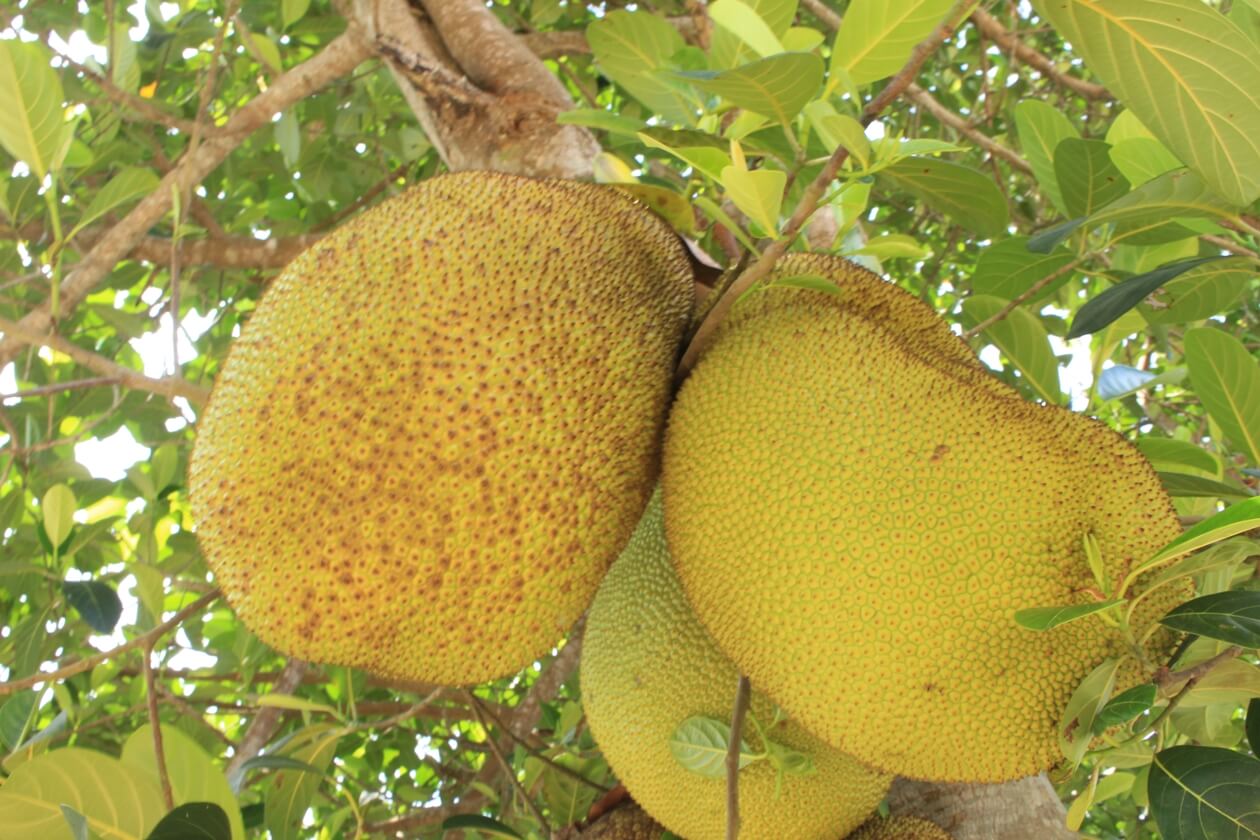
When visiting Vietnam, tasting its diverse and unique fruits can enrich your journey to explore this country.
In this post, we structure each part by following the fruit’s name in English and Vietnamese, including how it is, where it is the principal place to grow, the original seasons of harvest, how to eat, and the average price of each fruit.
1. Green apple
A green apple has a forefoot size and smooth skin. Its taste is similar to regular red apples but less sweet and crunchy.
Vietnamese green apples are grown everywhere in the country because they are one of the most accessible tropical trees. Green apple trees differ from apple trees in temperate countries because their trunks are smaller and often have thorns.
This green apple has various vitamins that are good for health. Because it is small and has hard-to-peel skin, most people eat its skin. However, we encourage you to wash and peel apples purchased at the market to ensure food safety.
Almost every market or supermarket in Vietnam sells this type of green apple at fruit counters for a very reasonable price. The peak seasons of green apples in Vietnam are August and December.
How locals eat it:
Wash and peel the skin of Vietnamese green apples and enjoy it right away, or dip in chili salt like green mangoes.
Price range:
Green apple has a price from 15,000 VND to 35,000 VND per kg.
2. Vietnamese orange (Quả cam)
Vietnamese orange, also known as green orange, is prevalent in most regions of Vietnam. The fruits are usually green on the outside but have a beautiful orange-yellow color inside.
Vietnamese oranges are renowned for their unique sweet and sour taste, packed with a generous amount of juice. Locals often use these oranges, rich in Vitamin C, to make refreshing orange juice, a popular choice in hot and humid climates.
In South Vietnam and the Central Highlands, Vietnamese oranges are harvested in May and June. However, another crop is harvested from November to December every year, which is the rainy season in central and northern Vietnam.
Orange growers want to get high prices and meet people’s consumption needs, so they have to take measures to interfere with the flowering and fruiting process for orange trees.
Thanks to careful harvesting techniques, green oranges are a common sight in local markets in Vietnam throughout the year, ensuring a steady supply for the locals.
People call this fruit type Green Oranges because gardeners harvest them still slightly green to transport and keep longer. If oranges are harvested with a yellow color on the skin, they are easy to spoil and do not preserve for long.
How locals eat it:
The locals use green oranges for juice, eat after meals, and add to the cake to create a fragrant flavor.
A popular way for tourists to taste this orange is to order a glass of orange juice. Orange juice provides many micronutrients, especially Vitamin C, which gives you more stamina for the trip.
Price range:
The average price of green oranges is 15,000 VND to 35,000 VND per kg.
3. Mango (Quả xoài)
Vietnamese mangoes are popular tropical fruits with a rich flavor. Each fruit averages 350 to 450 grams and is flat, kidney-shaped. When young, the fruits are green or light green with a very sour taste. When ripe, they become light yellow with fresh flesh and a sweet taste.
Visitors can find mangoes at most places in Vietnam. However, the best mangoes originate from Hoa Hung commune, Cai Be district, Tien Giang (the former name Hoa Loc commune, Giao Duc district, Dinh Tuong province) in the Mekong Delta.
Eating the ripe Hoai Loc mango (Xoài Cát Hòa Lộc) is tasty. You can feel the smooth meat, less fiber, and no matter how ripe it is, not be friable. Hoa Loc mangoes follow traders to many provinces and cities. They are also reaching out to the international markets in the US and Japan.
In South Vietnam, mango season usually lasts from the end of April to July. Many boats and trucks carry ripe, flavorful mangoes to other cities.
How locals eat it:
Many people like young mangoes, which are hard and sour. They peel thin skin, slide it into small pieces, and dip it into chili salt or a sauce prepared with chili, sugar, and fish sauce.
Ripe mangoes are tasted after cutting into small parts after meals. They also make mango shakes from these ripe fruits.
In addition, many factories dry ripe mangoes, pack them to preserve them longer and sell them at almost all Vietnamese supermarkets.
Price range:
The average price of fresh Hoa Loc mango is 60,000 – 80,000 VNN/kg.
4. Milk Apple (Quả vú sữa)
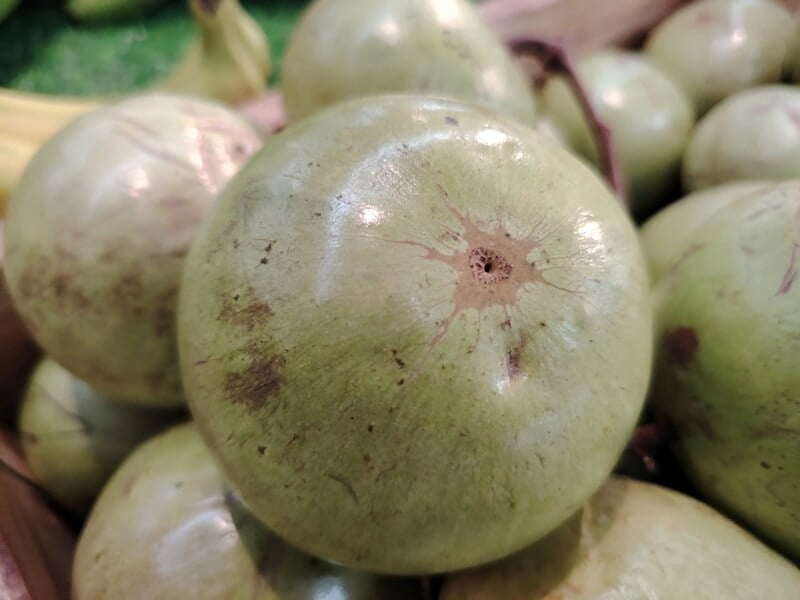
The milk apple is as big as an orange but rounder and has shiny skin. The fruit is bright green or purple and slightly soft.
When eaten, the inside contains a lot of juice, like milk; this is why it is called a milk apple, also known as “mother’s milk” in Vietnam.
Its slightly sweet flavor carries hints of pear and apple, while its delicate and unique aroma makes it a refreshing treat. Milk apples are also packed with vitamins, fiber, and minerals, providing essential energy and nutrients.
Milk apple is a popular tropical fruit in Central and Southern Vietnam. The Mekong region, especially Tien Giang province, produces sweeter and more fragrant products than other regions.
The primary season of the star apple is from January to March of the solar calendar every year.
How to eat:
When eating, cut the fruit in half and use a spoon to scoop out the pulp and flesh around the seed to enjoy. Please do not eat the hard part close to the skin because it will taste bitter.
The second way is that many people gently squeeze to soften evenly and pull out the stem of the star apple and suck out the liquid and water inside. However, be careful this way to avoid accidentally swallowing its seeds.
Milk apple price:
The price of star apples depends on the type, with the standard type ranging from 50,000 to 80,000 VND per kilogram at the markets.
5. Durian (Sầu riêng)
Durian is a typical fruit known as the “king of fruit” growing in South Vietnam. The durian trees in Vietnam came from Thailand and were first cultivated in the Tan Quy and Bien Hoa districts of Dong Nai province. Then, they spread to the Mekong Delta region and the Central Highlands.
The best durian is grown in Vinh Long commune in the Mekong Delta. For many people who have never eaten it, the smell can be overwhelming and intimidating, as can its thorny appearance. However, those familiar with its taste describe the flavor as a balanced mix of sweetness and creaminess.
Durian, also known as Durian Ri6, was named after Mr. Sau Ri, who created a prominent variety of durian in Vietnam. This variety is highly regarded for its nutritional content, including high levels of calories, carbohydrates, proteins, lipids, and minerals compared to other fruits.
A durian fruit typically weighs between 2 and 5 kg and often has large, bright yellow flesh inside, resembling a yellow butterfly when opened.
Durian trees usually flower twice a year: once from December to January, producing the first harvest in June and July and again from July to August, with the off-season harvest occurring in February and early March.
How locals eat it:
Durian can be tricky to eat for the first-taste person because of its hard thorn skin and strange smell. To open it, wear thick gloves and use a knife to pry open the top of the fruit carefully.
It’s easy to ask sellers to support you in doing this, and you receive the flesh to take it directly. Many others also use it to make cream or add it to sugar cane juice for a stronger flavor.
Price range:
The price of durian ranges from 90,000 VND to 180,000 VND/kg, depending on its size, for weighing whole fruit, including skin.
6. Dragon Fruit (Quả thanh long)
Dragon fruit is a vibrant, cactus-like fruit with dark pink or red skin. The two main varieties have white or red pulp, with the red being sweeter. This nutrient-rich fruit, high in vitamins B and C, is popular in Vietnam for its refreshing and cooling properties.
Originally planted as ornamental plants in the 1990s by Binh Thuan farmers in Central Vietnam, dragon fruit trees are now widely cultivated. Thanks to specialized growing techniques, they are available nearly year-round, with a peak season from June to September.
How locals eat it:
The Vietnamese typically slice dragon fruit into sections and eat it raw as a refreshing dessert. For its mild and sweet taste, it is also added to bread and used to make fresh smoothies or salads.
Price range:
Dragon fruit is affordable, costing between 15,000 to 25,000 VND per kilogram. Prices are slightly higher outside the peak season.
7. Mangosteen (Măng cụt)
Mangosteen, often called the “queen of tropical fruits,” is a beloved summer treat in Vietnam. Grown mainly in the Mekong Delta, its thick purple skin protects tender white segments, offering a balanced sweet and tangy flavor.
Ripe mangosteens are dark purple with soft, juicy white pulp divided into small segments. Medium fruits with three-finger sizes are ideal, as they often have fewer large seeds and more flavorful flesh.
In Vietnam, the mangosteen season- from mid-April to June- is eagerly anticipated, especially in regions like Ben Tre’s Cho Lach district, famous for its high-quality harvest.
How locals eat it:
To enjoy ripe mangosteen, gently slice through the thick skin with a knife, twist it open, and savor the juicy pulp. Be cautious of the seeds hidden in large segments. Locals also use unripe green mangosteen in refreshing summer salads for a tangy flavor.
While mangosteens offer many health benefits, it’s best to enjoy them in moderation, as they can cause allergic reactions in some people.
Price range:
During the peak season (mid-April to June), mangosteens are priced between 50,000 and 90,000 VND per kilogram. Outside this season, prices can rise to as much as 180,000 VND per kg.
8. Rambutan (Chôm chôm)
Rambutan, a beloved tropical fruit in Vietnam, is known for its vibrant red skin and unique, hairy texture. Rich in nutrients like Vitamin C, copper, potassium, and calcium, rambutan is a refreshing summer treat.
When opened, its milky white, sweet, and slightly sour flesh resembles that of lychees and longans. However, rambutan tends to be larger and longer than both, offering a juicier and sweeter taste than longans but less water content than lychees.
The fruit thrives in Vietnam’s Long Khanh district in Lam Dong provinces, where the climate and soil are ideal for cultivation. Its peak season is during the hot, humid summer months, from May to August when rambutan clusters turn bright red on the trees.
How locals eat it:
To enjoy rambutan, use a knife to gently score the skin and open it or squeeze it lightly to peel away the exterior and reveal the sweet, juicy flesh. Be cautious when eating, as the flesh can be tricky to separate from the seed.
Price range:
During its prime season, rambutan is typically sold by weight, not individual fruit, with prices ranging from 15,000 to 30,000 VND per kilogram.
9. Passion Fruit (Trái chanh dây)
Passion fruit has a round shape with a dark purple color and wrinkled skin when ripe.
Vietnamese passion fruits contain many tiny seeds covered by yellow flesh. The flesh can be eaten with a sour and fragrant taste, making the passion fruit a cooling drink.
Passion fruit has different names in Vietnamese, including Chanh leo, Chanh dây, or mát mát. Its scientific name is Passiflora incarnate, belonging to the genus of Lac Tien (Passiflora).
Passion fruit is rich in pectin – a fiber that helps you feel full without increasing calories. It also works to reduce bad cholesterol and improve the function of insulin. This fruit also contains vitamin A, flavonoids, and other phenolic compounds that help prevent cancer. (Source for health benefits of this fruit)
The Central Highlands of Vietnam is the main area where passion fruits can be grown. Their main harvest is from August to December.
The total production of passion fruit is 200000 tons, which are supplied for exporting and used in the domestic market.
How locals eat it:
Cut half, add a little sugar, and use a spoon to taste it immediately.
Another is to mix two passion fruits and 2 or 3 spoons of sugar and add ice to create a refreshing drink during summer.
Many locals use passion fruit for fried shrimps to add more flavor to shrimps for daily meals or parties.
Price range:
The passion fruit price is from 15,000 VND to 30,000 VND per kg.
10. Bon Bon Fruit (Trái bòn bon)
Bon Bon, also known as Lon Bon, is milky in color and double the size of an adult finger. It has a sweet taste like an apple or a bear combined, but it contains several bitter seeds.
This fruit contains rich vitamins (A, B1, B2, B3, C, and E), minerals (calcium, phosphorus, iron), and antioxidants, which offer healthy benefits, including improved heart health, reduced cholesterol, and migraine relief.
Bon Bon is a tropical fruit that grows in many countries in Southeast Asia, typically in Vietnam and Thailand. The main harvest period for this typical fruit is from October to December.
How locals eat it:
First, wash the fruit carefully and peel the skin from top to bottom using your hands. Then, enjoy it as you would any ripe fruit. Be cautious of the seeds, as they can be bitter.
Price range:
The price typically ranges from 30,000 VND to 60,000 VND, depending on the time of year and the quality of the fruit.
11. Guava (Quả ổi)
Vietnamese guava can grow in most of the provinces in Vietnam. This tree is easy to plant and care for, so many farmers like to develop the economy with it. Also, the flavor of ripe guava is odorous, so many people want to taste it. Thus, its market spreads all around Vietnam.
Guava is a round or oval fruit with light green or yellow skin. The flesh inside is white or reddish, with edible seeds. Vietnamese guava is a nutritious food. Guava contains many essential components and supports the body against disease.
100 g of guava contains about 126 mg of Vitamin C. Other nutrients in the fruits are also low in calories and high in fiber. Regular use of guava fruits can boost heart health and the digestive system, boost immunity, and protect the body from many pathologies.
The season of guava in Vietnam is from August to October. But, with the new technique to grow guava trees, you can find their fruits all year round in the markets in Vietnam.
How locals eat it:
Many locals eat nearly all of the guava; however, we recommend peeling the skin before eating to avoid chemicals and maintain good hygiene.
The way to eat guava is similar to tasting green mango; using it with chili salt is the most popular way to taste it and make juice.
Price range:
The average rate of guava is from 15,000 to 35,000 VND per kg.
12. Jackfruit (Quả mít)
Jackfruit is Quả mít in Vietnamese. This fruit is the same as a fast-growing tropical Asian tree related to the durian. Mit fruit has a fragrant smell and a big size of up to 15kg, but the durian has a bad smell at first taste and is much smaller than jackfruit.
Jackfruit trees grow all around Vietnam, but the large areas to cultivate them are in the Mekong Delta, including Cai Be (Tien Giang province), Phong Dien (Can Tho), and Thoi Lai (Hau Giang).
The feature of the jackfruit tree is to harvest nearly all year round, but the peak season is from June to August.
When the jackfruit is ripe, its inside contains large yellow zones with a sweet taste and scented flavor.
Jackfruit is rich in nutrients, such as vitamins A and C, calcium, iron, potassium, and magnesium, which benefit health.
However, when you feel hungry, you should not eat jackfruits. Also, avoid tasting it at night and chew its flesh carefully.
There are two kinds of jackfruit: dry and wet. The wet Mit is very soft and much easier to taste. The dry jackfruit is crunchy for those who like to chew.
How locals eat it:
The locals use green, unripe jackfruits to make shrimp soup or prepare a salad. Typically, unripe jackfruits have abundant sap, which is easy to stick on hand. So, you cut it carefully.
For ripe jackfruits, cut them and choose significant yellow segments (múi mít) to take; tiny white segments (xơ mít) are often for cows or pigs.
Price range:
The cost of jackfruit is 25,000 VND to 40,000 VND per kg, counted with all parts of jackfruits.
13. Custard apple (Quả na)
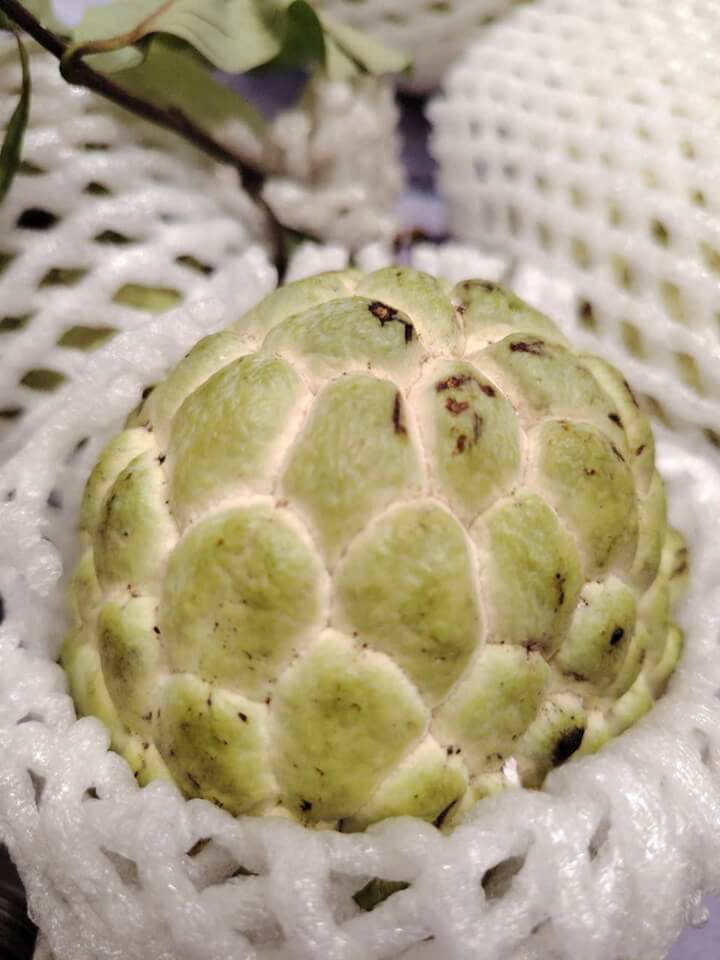
Many international tourists consider custard apples an exotic fruit in Vietnam because of their unique segmented surface, which looks like the holes in a honeycomb.
Custard apples are as big as an adult’s fist. When green, they have a pungent smell; when ripe, they have a sweet taste and a light aroma like pineapple. The ripe fruit is very soft and has many white pulps and long black seeds.
Custard apples are grown everywhere in Vietnam but are most famous in the northern mountainous region, especially in Lang Son province. Thanks to the limestone soil, the custard apples here taste sweet and are rich in nutrients such as B6, magnesium, and iron.
How locals eat:
When ripe, gently peel the skin of custard apples by hand along each segment. Put their flesh in a bowl or plate, and use a spoon to cut each piece to eat and feel the sweetness and aroma.
As mentioned, custard apples have many seeds, so you need to be careful when eating them to avoid swallowing the seeds, or you can remove them with a spoon or chopsticks before eating.
Besides eating directly, many people also use it to make sweet custard apple desserts or smoothies.
Price range:
Custard apples can be sold individually for about 10,000 VND each. If calculated by kilogram, the price ranges from 50,000 VND to 80,000 VND during the primary season, when they are sold at markets or supermarkets in Vietnam.
14. Vietnamese rose plum (Quả roi)
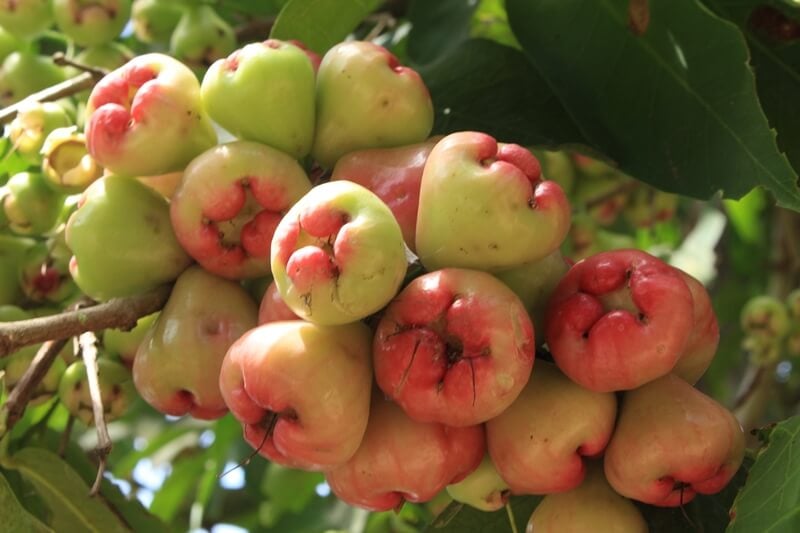
Rose plums are shaped like small, shiny bells, about 3 to 4 thumbs in size, and come in various colors: red, pink, or white, depending on the type.
Rose plums are crunchy, juicy, and slightly sweet when ripe, though they can be astringent when young. Their texture is similar to pears but more spongy.
In addition, rose plums are known as a food supplement of vitamins C and A, potassium, and fiber that is good for digestion. However, eating them on an empty stomach or eating a lot has the opposite effect, quickly causing bloating and indigestion.
Rose plums love hot and humid climates, so they grow well in the south-central region and the Mekong River region in southern Vietnam. The rose apple tree, which bears rose plums, is one of the longest-bearing fruit trees in Vietnam, with the harvest season lasting from November to June.
How locals eat it:
For a traditional treat, wash the rose plums carefully, cut them into four vertical pieces, and dip them in spicy chili salt.
Price range:
Rose plums vary in price, from 40,000 VND to 90,000 VND, depending on size and color. Red plums are usually the most expensive, followed by white and pink varieties.
15. Ambarella (Quả Cóc)
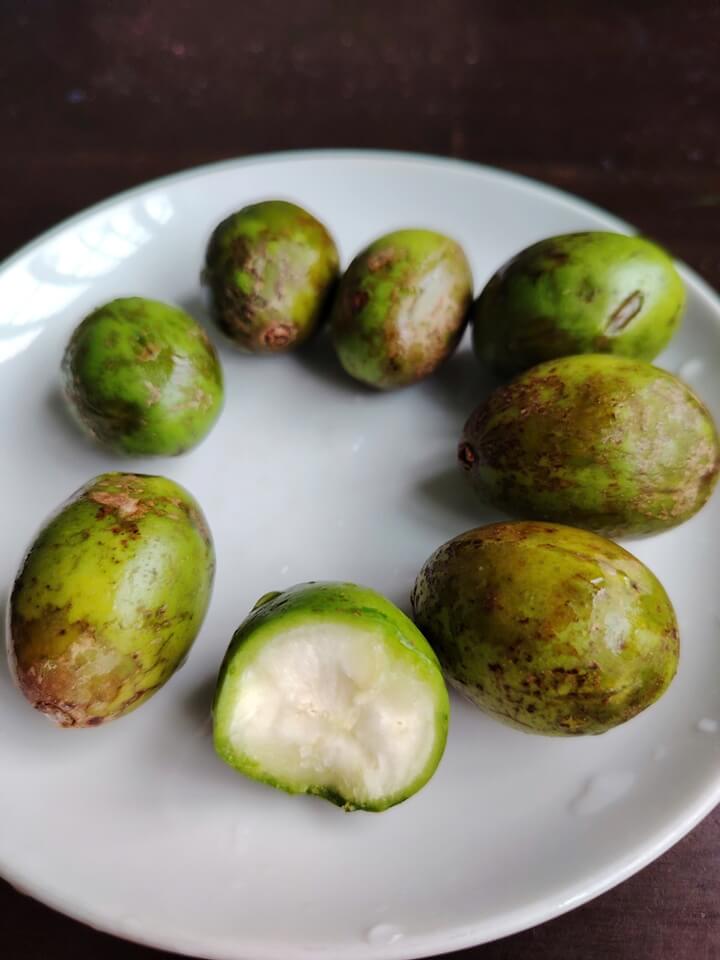
The ambarella fruit is deep green, oval-shaped, and about 2 to 3 fingers in size, roughly as long as a finger. When ripe, it turns slightly yellow, but most Vietnamese people prefer to eat it while still green.
The fruit is very sour and firm, similar to an unripe mango. It is commonly grown in the hot, humid regions of southern Vietnam, particularly in the South and Southeast.
Ambarella is rich in vitamins C and A, fiber, and other anti-aging and antioxidant compounds such as flavonoids, terpenoids, tannins, and saponins. (Source in Vietnamese)
How locals eat it:
For the best experience, choose small green ambarella fruits, which are crunchier. Wash and peel the skin—since the green skin is very sour, you can peel it thicker if you prefer a less tart taste. The fruit is often dipped in salt and chili, becoming a favorite snack among many young people.
Many women also enjoy shaking ambarella to make juice and drinking it a few times a week for its health benefits.
Price range:
Ambarella fruits are priced from 20,000 to 30,000 VND per kilogram.
Vietnam has plenty of tropical fruits with different tastes and flavors. Tasting some fruits can make your holiday experience more enjoyable when you visit the country.
However, for some strange fruits you have never eaten, try a little to know their taste and how they are. This skill protects the body from being influenced by different foods.
Always wash fruits when buying them from a market or supermarket. Peeling their skin is another safe way to taste fruits in Vietnam.
With these tips, you can enjoy Vietnamese fruits better and make your journey more memorable.
Which fruit do you like best?

